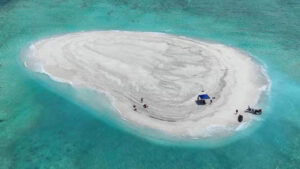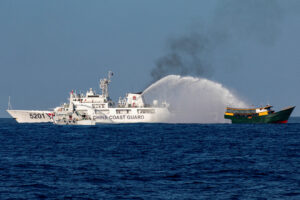Philippines, China should agree on status quo at Sandy Cay — analysts

By Kenneth Christiane L. Basilio, Reporter
THE PHILIPPINES should strike a deal with China to keep the status quo at a contested sandbar in the South China Sea while it continues to challenge Chinese aggression at sea, security analysts said at the weekend.
“Agreements such as both sides refraining from constructing anything at Sandy Cay would be the best outcome for now,” Justin Keith A. Baquisal, a national security analyst at FACTS Asia, said in a Viber message.
“What Manila really needs to do is to establish its credibility that any Chinese attempt to occupy the feature would be met at a tactical level with consequences,” he said. “If we cannot threaten reciprocal escalation, then our posturing at Sandy Cay is not credible.”
Chinese state media in late April reported that China’s coast guard had asserted sovereignty over Sandy Cay — a small coral reef west of Thitu Island on the northern side of Thitu Reefs of the Spratly Islands — by landing and displaying Beijing’s national flag there.
The Philippines has denied China’s claim over the sandbar, deploying its own contingent of troops shortly after to reinforce its position and challenge Beijing’s assertion of control.
“It’s not enough that we show China that we can also land at Sandy Cay and have a photo-op and raise our flag,” Mr. Baquisal said. “The actions at Sandy Cay are not qualitatively new, so the challenge for the Philippines is to continue asserting its presence in the area through patrols.”
“What’s critical is the logistical capacity to have a stare-down in the area if and when China tries a similar provocation again, and this involves numerous ships, air assets and marine detachments,” he added.
Sandy Cay is close to Thitu Island, the largest feature occupied and developed by Manila in the Spratlys, where Vietnam, Taiwan, Malaysia and China also have a presence.
Manila should fast-track the development of military facilities along its western seaboard, such as the joint Philippine-US-operated Antonio Bautista Air Base, to strengthen its presence in the contested waters, Mr. Baquisal said.
Beijing claims more than 80% of the South China Sea based on a 1940s nine-dash line map that overlaps with the maritime zones of several Southeast Asian nations. It has deployed an armada of coast guard ships to assert its sovereignty despite a 2016 ruling by a United Nations-backed tribunal that voided its claim for being illegal.
The Philippine government should ask the US to deploy its naval assets near the disputed reef alongside its forces to flex their joint force capabilities to prevent further incursions like what happened at the sandbar, Mr. Baquisal said.
The US deployed its Nimitz aircraft carrier group to the Philippine Sea in late April where it practiced day and night flight operations and tested its ability to rapidly deploy military jets in various weather conditions, according to the US Indo-Pacific Command.
The Philippines should continue calling out China over its actions in the South China Sea to inflict reputational costs on Beijing’s increasing assertiveness at sea, said Chester B. Cabalza, founding president at Manila-based think tank International Development and Security Cooperation.
“China loses its credibility if it continues with its untruthful and illegal claims in the Philippines’ exclusive economic zone,” he said in a Facebook Messenger chat. “The consistency of our legal claims is a powerful act in itself. The world believes in us.”
The Philippine government should not build any structures on the contested sandbar since it could worsen tensions and derail a long-awaited South China Sea code, the analysts said.
“Developing Sandy Cay is contrary to Manila’s stance on the status quo since it inked an agreement on the 2002 Declaration on the Code of Parties that it will not develop maritime features,” Mr. Cabalza said.
The Association of Southeast Asian Nations (ASEAN) and Beijing pledged in 2002 to come up with a code of conduct on the South China Sea, a framework that seeks to prevent conflict through diplomatic means, but it has remained elusive due to slow progress.
The South China Sea has become a regional flashpoint as Beijing continues to assert sovereignty over almost the entire sea, seen as a vital global trade route that is believed to be also rich in undersea gas and oil deposits.
Philippine Foreign Affairs Secretary Enrique A. Manalo last month said ASEAN and Beijing are “politically committed” to finalize the South China Sea code by next year, when the Philippines hosts the regional grouping.
“Developing Sandy Cay is not a solution,” Mr. Baquisal said. “China would likely not allow the Philippines to build anything on it, and if we do, Beijing will use that as an excuse to forcibly take Sandy Cay.”




